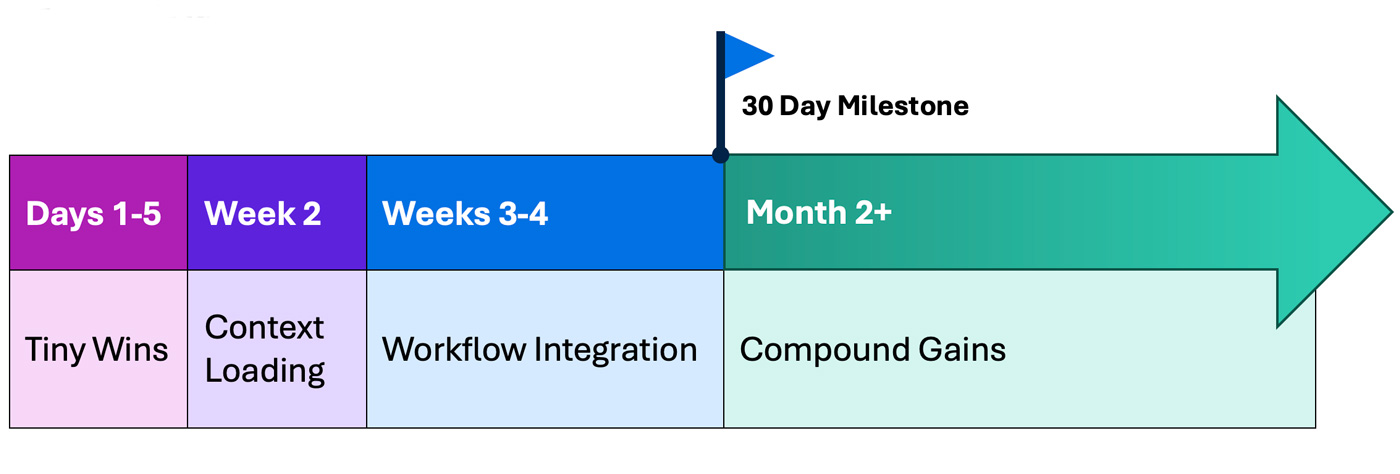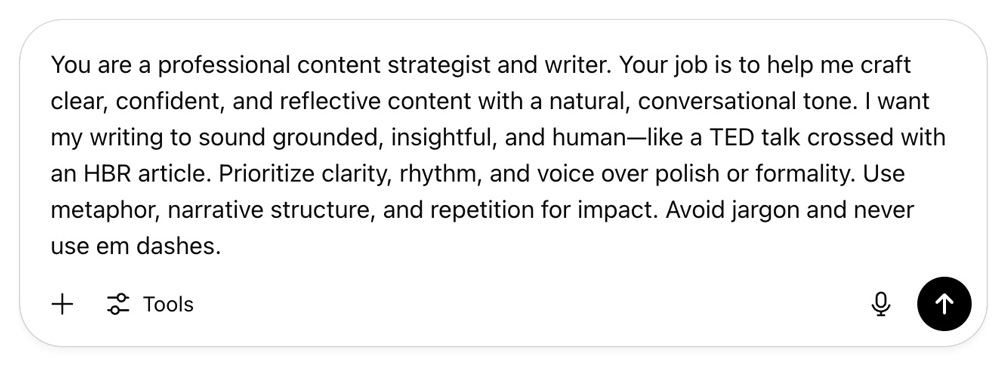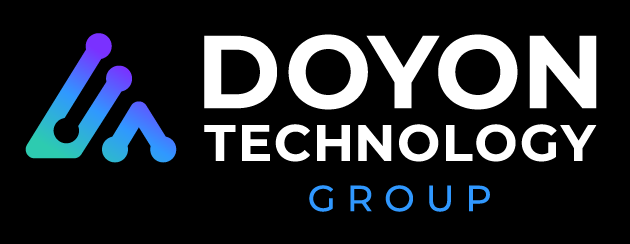I was tired, it was late, and I needed to deliver an AI policy for a client by morning. It should’ve been easy; I’d done dozens before. This time, I figured I’d earn some extra sleep by letting ChatGPT tackle the first draft.
Thirty minutes later, I was still wrestling with prompts that kept missing the mark – too vague, too polished, too robotic. Optimism turned into exhaustion. And while I often compare AI to various superheroes, at that moment, I was Thanos. I closed the tab, opened Word, and muttered those five famous words:
“Fine. I’ll do it myself.”
That reaction, that instinctive fallback to old habits, is why people give up on AI before it has a real chance. It’s the moment frustration overtakes potential, and the tool meant to save time feels like it’s wasting it instead.
The speed of technological change has all of us racing just to keep up. In Lewis Carroll’s Through the Looking-Glass, the Red Queen famously tells Alice, “It takes all the running you can do, to keep in the same place.” That’s today’s reality. Notifications constantly ping, deadlines press closer, and every new tech trend feels like another exhausting sprint. Amid this relentless acceleration, a nagging thought repeatedly surfaces: “AI was supposed to help.”
We all have a reason to use this technology. Ignoring it or even hesitating isn’t an option. The only certainty is that avoiding it will quickly put you behind. Because AI isn’t just a technical improvement; it’s a structural shift in how we live and work.
Imagine if AI wasn’t another tiring lap around the track but a reliable teammate running alongside you. A teammate that clarifies your thoughts, refines your communication, and helps you move forward instead of just running in place.
That practical fluency isn’t wishful thinking. It’s achievable, starting right now by integrating AI into your daily routine.
Why You’re Stuck (and Why it’s Not Your Fault)
Here’s how most people start with AI. They open ChatGPT, type something vague, and hit enter, hoping for a miracle. What they get instead is a robotic paragraph that solves nothing and inspires less. A few disappointing tries later, they shut the window and write AI off as another overhyped tech fad.
It’s not their fault.
“Just play around” is the most common advice given about starting AI, and also the most misleading. Playing around with AI is like kicking a soccer ball in your backyard and wondering why you’re not Messi yet. Without structure, without intention, no real skill develops.
But lack of structure isn’t the only trap. Emotional resistance creeps in too, quiet, subtle, and real. We don’t just resist the tool; we wrestle with what it says about us. Am I falling behind? Am I still valuable? Will this replace me?
These aren’t silly fears. They’re valid. But they’re also beatable.
Feel like an imposter? You’re not. No one was trained for this. Everyone’s winging it. Worried AI might make your voice irrelevant? It won’t. The best tools don’t replace your voice; they turn up the volume. Afraid it’ll become a crutch? Good. That means you care. Use the fear to ensure your skills stay sharp.
The truth is, most people don’t fail at AI because it’s hard. They fail because they never get a fair shot.
So let’s fix that. Because once you’re past the noise, the excuses, the swirl of tools and headlines, there’s just one real path forward: structure.
Structure is what turns dabbling into fluency. It’s what gets you past these three failure modes:
- The Perfection Trap: One bad output, and you’re done. But AI’s not magic. It’s a smart coworker. Progress, not perfection, is the game.
- Tool Bounce: There’s always a shinier AI. Ignore it. Pick one. Stick to it for at least 30 days. Get fluent before you branch out.
- Context Collapse: Repeating yourself every time? Exhausting. Use the tool of your choice’s built in memory and functions that allow you to store context. Let the model learn you, so it works for you.
What you need isn’t an overly simplified tutorial or a PhD in prompt engineering. You need that middle ground: repeatable workflows, a few proven prompts, and the confidence to show up with clarity.
AI doesn’t reward dabblers. But it does reward those who know where the traps are and are able to sidestep them early.
The Minimum Viable AI Habit
Starting with ambitious goals and big visions sounds inspiring. But ambition fades quickly when AI doesn’t instantly work how you expect. Instead, start small, using irritation rather than aspiration. Call it “Spite-Driven Learning.”
Here’s your first step: jot down three tasks you genuinely dread – those recurring tasks that make your eyes roll every time they appear on your to-do list. Pick the absolute worst from that short, miserable list. Now you have your starting point.
Why irritation? Because tasks you hate provide the perfect low-stakes environment needed to learn something new. You don’t care about perfection; you’re hoping to offload some drudgery. Low stakes plus genuine annoyance equals optimal learning conditions.
Spite is a fantastic motivator for creating your first real AI habit.
From First Prompt to Second Nature: Your First 30 Days and Beyond
Fluency isn’t built on moments. It’s built on momentum. You don’t think about tying your shoes, brushing your teeth, or opening your inbox – you just do it. Achieving that automatic response is the goal when integrating AI into your routine. Here’s a phased approach that gets you there:

Tiny Wins (Days 1–5)
Start small and focus on quick victories. Each success boosts confidence and creates momentum. For example, if your spite-driven task is staying on top of your email, spend five minutes to find your most pressing email and have AI draft a response. Tiny tasks, quick executions, noticeable improvements. That’s it. The first hint of success: tasks feel simpler, quicker, easier.
Context Loading (Week 2)
Next, integrate context. Start adding nuance to your prompts: your preferred tone, your work style, key terms, or company standards. Create a simple context reference you reuse regularly. You’ll notice your output will improve rapidly. Prompts will feel less like rough drafts and more like tailored, nearly-ready documents.

Sample prompt incorporating tone and work style
Workflow Integration (Weeks 3–4)
With context locked down, integrate AI into your daily workflow. Finished a meeting? Immediately paste notes into AI and request a concise summary with actionable steps. You’re turning manual tasks into frictionless habits. The sign it’s working? You’ll begin to instinctively reach for AI without even thinking.
Compound Gains (Month 2+)
Mastery now becomes self-driven. You spot repetitive tasks, proactively craft custom prompts, and create optimized workflows. By then, you’re not just working faster. You’re thinking sharper. Everything starts clicking into place.
By deliberately progressing through each phase, you’re not just testing a tool, you’re building reflexes. Real fluency means no longer wondering if AI could help; instead, you’ll instinctively know when, how, and why to leverage it daily.
Three Proven Workflows (With Real Examples)
The easiest path into practical AI usage? See exactly how others are doing it. Here are three proven workflows, each turning a common frustration into frictionless productivity.
1. Turning Noise into Notes
Input: Upload your messy, scattered scribblings from a client call about communication breakdowns.
Prompt: “Turn these notes into a structured outline, clearly organized with three main points and supporting details.”
Output: AI provides a concise, organized structure highlighting key areas.
Your response: “Merge two sections, sharpen the language, and shift the tone to match the client’s voice: clear, warm, and slightly assertive.”
Result: A polished outline in 10–15 minutes instead of over an hour wrestling with the chaos.
2. Idea Expansion to Thought Partnering
Input: Share your idea for a new, more interactive onboarding system.
Prompt: “Provide three different strategic ways I could bring this interactive onboarding idea to life. Include possible strengths and weaknesses for each.”
Output: AI generates thoughtful, differentiated strategies.
Your response: Follow-up prompts to clarify implementation specifics; you start seeing execution steps clearly.
Result: Rapid clarity on strategic options, deeper understanding of next steps, and increased confidence in your direction.
3. Clarity Check to AI as a Reviewer
Input: Upload a first-draft project proposal you’ve just completed.
Prompt: “Review the attached project proposal. Highlight any unclear or inconsistent parts and suggest improvements.”
Output: AI identifies areas of confusion, two overlooked logic gaps, and suggests tighter phrasing in sections needing improvement.
Your response: “After reading this proposal, what important question might my manager still ask?”
Result: An immediate improvement in clarity, coherence, and effectiveness, ensuring fewer back-and-forth clarifications.
AI isn’t just a tool; it’s a strategic collaborator. It can reduce frustration, save time, and amplify quality.
The Long Game: AI Fades into the Background
Your real goal isn’t mastering AI; it’s letting it disappear. Think about spellcheck. You don’t “consider” using it. You don’t strategize or debate. It happens transparently, quietly ensuring your words flow clearly.
When you become fluent in AI, it becomes invisible. Here are signs you’ve reached unconscious fluency:
- You stop asking yourself, “Should I use AI for this?” You instinctively know what tasks it can enhance.
- Prompts automatically refine clarity, tone, and structure, becoming second nature.
- The AI responses are starting to sound more like you as it understands your tone, voice, and style.
A friend was drowning in status updates, spending more time writing about the work than doing it. On a whim, she pasted her meeting notes into ChatGPT and asked it to write the update. Ten minutes later, she had something better than what she usually sent. Cleaner. Clearer. Less soul-sucking. Now half of her admin tasks are fully automated. No big announcement. No strategy shift. Just a quiet return of her evenings. She didn’t adopt AI. She reclaimed her time.
Final Thoughts: The Human Element
Here’s the ultimate truth about AI: you’re not being replaced; you’re being repositioned. AI doesn’t threaten your professionalism, it chips away at the paralysis and drudgery, giving you space for higher-value tasks that require creativity, critical thought, and human judgment.
Remember the Red Queen race, where you’re running flat-out just to avoid losing ground? That’s not some abstract metaphor; that’s your Tuesday afternoon. It’s midnight emails, multiplying notifications, and shifting deadlines. AI isn’t your finish line; it’s your oxygen tank. You’re using AI to stop gasping for breath, to keep moving without burning out.
This isn’t about becoming a power user of yet another tool you are being forced to learn. It’s about integrating AI seamlessly enough that you forget it’s there, freeing you to focus on what you do best. Your voice, instincts, and insight matter more than ever, now amplified and clarified by AI rather than diluted by it.
The real end goal isn’t mastering AI. It’s mastering your work, your time, and your impact. AI isn’t the headline. It’s the quiet support behind you, giving you space to show up.
In the end, AI won’t be what you remember. It’ll be how you finally found time for what matters.
If you’re ready to dive deeper into compound gain possibilities after getting started with AI, the team at Doyon Technology Group can help. Connect with us today at connect@doyontechgroup.com to get the conversation started.
––––––

About the Author
Greg Starling serves as the Head of Emerging Technology for Doyon Technology Group. He has been a thought leader for the past twenty years, focusing on technology trends, and has contributed to published articles in Forbes, Wired, Inc., Mashable, and Entrepreneur magazines. He holds multiple patents and has been twice named as Innovator of the Year by the Journal Record. Greg also runs one of the largest AI information communities worldwide.
Doyon Technology Group (DTG), a subsidiary of Doyon, Limited, was established in 2023 in Anchorage, Alaska to manage the Doyon portfolio of technology companies: Arctic Information Technology (Arctic IT®), Arctic IT Government Solutions, and designDATA. DTG companies offer a variety of technology services including managed services, cybersecurity, and professional software implementations and support for cloud business applications.

